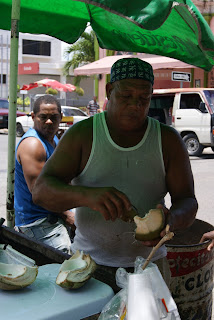Yesterday we had the chance to sit down with Ramona Jimenez, one of our clients. Ramona has always felt very comfortable with us, and we consider her a close friend. During our conversation yesterday, she explained in great detail one of the most difficult moments of her life.
Before 1998, she lived a very comfortable life; her husband had a steady job and they had managed to acrrue some savings during the years. In 1998 they decided to start a business in Batey Aleman. The business that they built was the biggest Colmado (corner store) in the community. It was two stories tall and provided all the goods the community needed. They had been able to purchase half of the store's inventory with their savings, and the other half they borrowed on credit from a department store in San Pedro de Macoris, the local town. Everything was going well, they couldn't believe they had accomplished one of their dreams: to start their own business.
Their lives changed just one week after opening the business. In September of 1998, Hurricane George struck the Dominican Republic and other Caribbean Countries. Batey Aleman was hit particularly hard. Their newly-opened store, as well as her house and most of the community, was completely devastated by the force of the storm. Ramona's family lost everything, from their beds to the goods in the Colmado. They were completely devastated emotionally, psycologically and economically. Their dream had fallen apart. They had to send their kids to sleep at the Pastora's (Local Pastor) house, since they didn't have a place for them to sleep, while Ramona and her husband slept on the floor in the only standing room in the house. They used garbage bags for bedding, so that they wouldn't have to sleep on the wet floor.
Ramona and her husband had borrowed half of the store's stock on credit, and with all of the goods destroyed, they had no way to repay what they had borrowed. The store confiscated the family's car, the only source of lump sum capital they had left.
Ramona finished her story with this statement:
"Faith, hope and life is all I need to move forward. Money is the least important thing. Thank God we are alive and that all my family members are healthy. Life is the most important thing in the world."

Ramona has been chosen the leader of the cooperative becaue of her good nature and sense of responsibility. She asked us if, as leader of the cooperative, she would be responsible for repaying the loan in the event that the other women defaulted. We were so thrilled to be able to explain to her that Nest is not like the department store that took the only thing they had left as repayment for a loan. We assured her that Nest is only here to help her reach her goal, and that in the event that something goes awry with the repayment plan, Nest will immediately open discussion with her and the rest of the women to find out what the problem is, and then rework the plan to fit their needs. Nest's program is aimed at teaching the women how to efficiently handle money and manage a business, and we explained to Ramona that she should never worry about losing any personal capital or possessions while working within a Nest program.
Listening to her talk about such a catastrophe and struggle moved us beyond words. She is an example of perseverence, hope and faith, and is one of the strongest woman we have ever met. She is so happy and thankful that Nest is giving her a second opportunity to accomplish her goal of launching her own business.












































